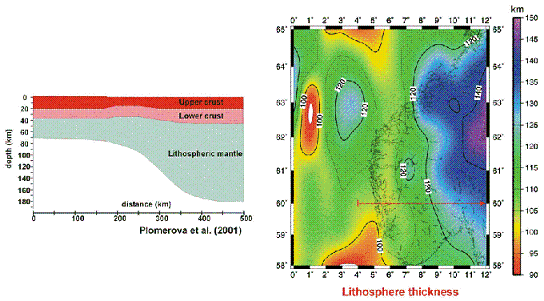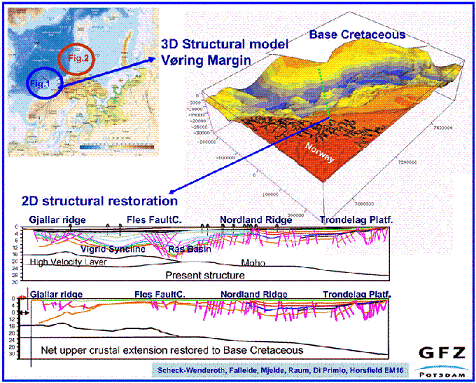The prime scientific objectives of this EUROMARGINS proposal are to advance understanding of:
1) processes and events during the formation of a volcanic margin, i.e. from onset ofrifting to onset of "normal" sea floor spreading;
2) the processes controlling post-breakup history of a volcanic margin.
To this aim we have selected the NW European volcanic margin as a natural laboratory. In particular the Mid-Norway Margin offers a comprehensive, high-quality database for an integrated study by a multidisciplinary team of researchers working on constraints for crustal architecture and margin topography and research groups with recognized modelling expertise on lithosphere- and surface-processes in rifted margin systems. This study holds also considerable potential for a close feedback with related complementary EUROMARGINS studies focussing on the collection of new geophysical datasets on deep-crustal architecture offshore Mid-Norway and East -Greenland. At present a unique opportunity exists for EUROMARGINS researchers to make a breakthrough by connecting better understanding of breakup tectonics at volcanic rifted margins to new concepts on tectono-thermal and geomorphological development in volcanic margin borderlands. The natural laboratory of the NW European volcanic margin is extremely well suited for well-constrained numerical and analogue modelling.
NEMSDYN Presentation
The prime scientific objectives of this EUROMARGINS proposal are to advance understanding of:
1) processes and events during the formation of a volcanic margin, i.e. from onset of rifting to onset of "normal" sea floor spreading;
2) the processes controlling post-breakup history of a volcanic margin.
This report highlights the results obtained during the first phase of projects IP-1 and IP-3 of the EUROMARGINS program: IP-1 Integrated modelling on post-breakup margin inversion
Principal Investigator: Dr C. Pascal & Prof. Dr. S. Cloetingh (Free University, Amsterdam), and IP-3 Structural modelling and modelling of subsidence history in order to reconstruct and quantify the tectono-sedimentary evolution and the generation, migration and alteration of hydrocarbons offshore Norway Principal Investigator: Prof. Dr B Horsfield & Dr. M. Schenck-Wenderoth (GFZ, Potsdam, Germany)
During the first phase of IP-1, the focus was on the development of new numerical tools for quantifying gravitational body forces, due to topography and density heterogeneities in the lithosphere, and their impact on margin systems. The method involves also quantification of lithosphere strength. Computations account for a wide range of geophysical and geological datasets (i.e. heat flow, topography, crustal structure, gravity measurements). The method represents a significant improvement compared to similar numerical tools developed by previous researchers that ignore crucial heterogeneities in the lithosphere.
The programming and testing phases of this new numerical tool have recently been terminated. The very first results obtained from its application to Fennoscandia suggest that, in absence of tectonic forces, strong gradients in in-situ gravitational forces exist in the vicinity of the mid-Norwegian margin.
 |
 |
The scope of the IP-3, encompassed in its title, is being addressed in two thrusts, one centred on the Voring Basin and the other on the Barents Sea. The processes that on the one hand control, and on the other result from, the post-break-up history of the Norwegian margin are of central interest. Thus, the prediction of temperature and pressure fields over geological time, and the physicochemical response of the organic matter via generation, migration, leakage and sequestration are of paramount importance, as is the ongoing coupling with climate.
The project started mid-November 2003 with the employment of Andrew Cavanagh as a post-doc. After a short phase of getting updated on the most recent literature an inaugural visit to Norway in mid-December provided the opportunity to meet partners from the Universities of Bergen and Oslo, the Norwegian Geological Survey and the oil companies Norsk Hydro and Statoil. Especially the discussions with the University of Oslo proved to be essential, as they agreed to provide interpreted seismic transects to the group. Thus, the first milestone of our initial work plan was partially attained. Therefore a major task – to compare the evolution of the rifted and of the sheared parts of the margin before and after break-up as well as during Cenozoic glacial isostatic adjustment- could be addressed directly.
We have chosen a two-fold approach to compare the rifted and sheared parts of the margin. On one side the rifted part of the margin is analysed using structural restoration of the four transects provided by the University Oslo to quantify subsidence and uplift as well as shortening and extension. The results from restoration will be implemented in a thermal history model. On the other hand the sheared part of the margin is investigated by means of a thermal history model along two transects published on the website of Norwegian Petroleum Directorate.
The first outcomes are obtained from structural restoration of a transect running NW-SE from the Trondelag Platform in the east to the Voring Marginal High in the west. These results suggest that the impact of Quaternary glacio-isostatic vertical movements concerns only the eastern part of the Trondelag Platform, but the Cretaceous/Paleocene structural history has to be implemented in the evaluation of the generation and maturation of organic matter.
The first modelling exercises have also been performed for the sheared part of the margin, the south-western Barents Sea. There, key areas and petroleum systems have been defined relevant to an investigation of the hydrocarbon response to tectonic-sedimentary evolution and model sections have been chosen.
 |
 |
Project Leader:
- PaulAndriessenE-Mail
- Vrije Universiteit AmsterdamFaculty of Earth and Life SciencesDepartment of Isotope GeochemistryAmsterdamNetherlands
Principal Investigators:
- Jean-PierreBrunE-Mail
- Université de Rennes 1Département de GéosciencesUMR 6118 CNRSRennesFrance
- Jan IngeFaleideE-Mail
- University of OsloDepartment of GeosciencesBlindernNorway
- BrianHorsfieldE-Mail
- GeoForschungsZentrum PotsdamDept of Organic ChemistryPotsdamGermany
- MagdalenaScheck-WenderothE-Mail
- GeoForschungsZentrum PotsdamSection 4.4: Basin AnalysisSect. 4.3: Organic geochemistryPotsdamGermany

